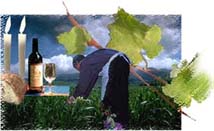|

The agricultural fate
of the seven varieties mentioned in the Bible (wheat, barley, vines, fig
trees, and pomegranates, olives for oil and honey (Deut. 8:7-10) is determined
in the critical period between Passover and Shavuot. In the Land of Israel,
this season is distinguished by multiple changes and climatic contrasts scorching
southern winds alternating with cold, wet winds from the north and west;
a successful harvest is dependent on the delicate balance and exact timing
of these opposing forces of nature.

"I will give you rain for your land in season, the early rain and the late
rain,
that you may gather in your grain, your wine and your oil." (Deut. 11:14)
It is easy to see how the
opposing climatic phenomena which determine the fate of crops could logically
have been viewed as battles between various deities; herein lay the very real
danger of "being lured away to serve other gods,"[1]
the gods worshipped by the local Caananites. Of the seven varieties, four have
the greatest importance in the land of Israel: wheat, barley, grapes and olives.
These, mentioned throughout the bible by the names grain (wheat and barley),
wine (from grapes), and oil (from olives), are the main representatives of the
seven varieties in whose successful growth lay those pitfalls that could lure
the Israelites to worship other gods. In this vein, it is possible to understand
the bitter reproach voiced by the prophet Hosea: "She [Israel] did know
that it was I who gave her the grain, the wine and the oil, and who lavished
upon her silver and gold which they used for Ba'al." [2]
Grain, wine and oil are
thus included in the passage from Deuteronomy which the Israelites were commanded
to recite morning and evening and to write upon the doorposts of their houses
and upon the gates of their cities: "If you pay heed to the commandments
I give you this day… And I will provide pasture in your fields for your
cattle; and you shall eat your fill. Take heed lest you be lured away and turn
aside to serve other gods and worship them, and the anger of the Lord be kindled
against you, and He shut up the heavens, so that there will be no rain, and
the land not yield its harvest…."[3]
The Talmud
transmits a tradition in the names of the Rabbi Yohanan, Resh Lakish and Rabbi
Elazar:[4]
"When the Temple
stood, the altar expiated man. Now that the Temple does not exists, man's
table expiates him."[5]"
 How
is it possible that a table can replace the Temple altar? When the Temple existed,
the Israelites brought offerings of fine flour mixed with olive oil to be burned
on the altar.[6]
Added to this offering was a libation of young wine. All of these offeringsgrain,
oil, and wine were brought to the altar together to symbolize the
prayer to the One creator that He bring the forces of nature into the necessary
balance, that the "southern wind" and the "northern wind"
complement each other. How
is it possible that a table can replace the Temple altar? When the Temple existed,
the Israelites brought offerings of fine flour mixed with olive oil to be burned
on the altar.[6]
Added to this offering was a libation of young wine. All of these offeringsgrain,
oil, and wine were brought to the altar together to symbolize the
prayer to the One creator that He bring the forces of nature into the necessary
balance, that the "southern wind" and the "northern wind"
complement each other.
After the destruction
of the Temple, the same crops became symbols on the "table of man"
each Friday night, the eve of the Sabbath: hallah bread representing
grain, wine representing the libation, and candles (replacing the early
oil lamps) representing olive oil. Thus we see that the Land of Israel
is also symbolically present on the Jewish table every Sabbath. This is
yet another way in which the land of Israel had been preserved as an integral
part of the structure of Judaism from generation to generation, throughout
the wanderings of the Jewish people.
|
[1]
Deut. 1 . [back]
[2]
(Hosea
2:10) (Ba'al was one the chief Canaanite deities, the god of rain). [back]
[3]
Deut. 11:13-16) [back]
[4]
Rabbi Yohananleading Sage of the Jerusalem Talmud, head of
the Academy in Tiberias; belonged to the second generation of amoraim
(sages mentioned in the Gemara or active during the period that it was
being compiled) (250-290 C.E.). Resh Lakish (Rabbi Simeon ben-Lakish)
was a contemporary of Rabbi Yohanan at the Academy in Tiberias. (He was
a gladiator in his youth!) Rabbi Elazar ben-Pedat was also from the second
generation of amoraim. Because of his exceptional scholarship,
he succeeded his teacher as head of the Tiberias Academy. [back]
[5]
T.B. Menahot 97a; Hagiga 27a [back]
[6]
These offerings are mentioned numerous times in the Bible; see Numbers
28:9. [back]
|
|
From:
Nogah Hareuveni, Nature in Our Biblical Heritage (trans. Helen
Frenkley), Israel: Neot Kedumim, 1980; pages 42-45; Neot
Kedumim, the Biblical Landscape Reserve in Israel. |
WINE
Table of Contents
|